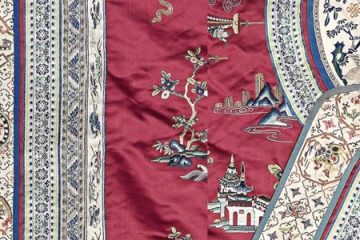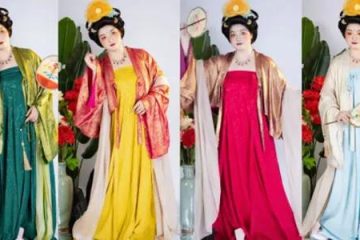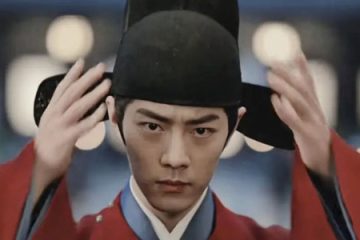The Sporty Side of Hanfu: Tieli & Yesa Robes

Beyond the classic Dao robe we have discussed before, there’s another category of Ming dynasty menswear that’s gaining modern popularity—Tieli (贴里) and Yesa (曳撒). These styles fall under what’s known as the “duan-yao”(断腰) robe structure, meaning the robe is visibly divided at the waist. They were commonly worn by men in the Ming era and are sometimes called the “activewear” of traditional Hanfu due to their practicality and ease of movement.
For example, in the historical drama The Glory, the character Zhuang Yushan, the second daughter, is often seen in a pink, dress-like outfit with a flared Chinese dress. Though portrayed on a female character, this style is actually based on Tieli, a traditionally male garment. Yesa is a similar silhouette, and both were heavily influenced by Mongol Yuan dynasty styles that were later sinicized (adapted to Han Chinese culture) during the Ming dynasty.

According to Ming Gong Shi, an official Ming palace record, the Yesa was designed as follows:
“The back panel is uncut, the sides feature flaring panels, and the front is constructed in two sections, with horse-face pleats extending to the sides.”
Both garments were typically worn by men, and when seen on women, it was usually part of a “cross-dressing” fashion trend in which women adopted traditionally male attire—sometimes for dramatic effect, sometimes for practicality.
I. What’s the Difference Between Tieli and Yesa?
1. Structure and Design
Tieli and Yesa both trace their origins to the bianxian robes (辫线袍) from the Mongol Yuan dynasty. At first glance, they look quite similar: both feature cross collars, right lapels, and a two-part construction where the top and bottom sections are sewn together. They also both have pleated skirts at the bottom.
But if you look closer, there’s a clear difference in how those pleats are arranged:
Tieli has pleats all the way around, like a finely gathered pleated skirt.
Yesa, on the other hand, features a “horse-face” pleat in the center front — much like the Mamian skirt worn by women — and the rest of the skirt remains relatively flat.

Here’s a simple trick to tell them apart:
Yesa (left in the photo): Has a smooth back with no pleats and is cut from a single piece of fabric in the back.
Tieli (right in the photo): Has visible pleats at the back and is made with separate fabric panels sewn together.
2. Social Class and Function
Tieli was more versatile and widely worn. From nobles to scholars and even commoners, people across social classes wore Tieli. It could be worn as an inner layer or as outerwear. When worn outside, it was often luxurious and ornate, sometimes featuring dragon or python patterns. But when worn underneath, it served a more practical purpose — its skirt-like pleats helped give structure and shape to outer garments.
Yesa, however, was more ceremonial and elite. In the Ming dynasty, it was commonly worn by royals, nobles, and government officials. By the mid-Ming period, it had evolved into a type of military formal dress, known for its grand, dignified appearance.

Ⅱ. A Quick Note on the “Flying Fish Robe”
Among Hanfu enthusiasts, you’ll often hear the term “Flying Fish Robe”—but technically, that’s a bit of a misnomer. “Flying Fish” actually refers to a pattern, not a specific garment style. It depicts a mythical creature with a dragon’s head and a fish’s tail—dragon-like, but not quite a dragon.
In the Ming dynasty, robes with this motif were imperial gift garments, but not the only kind. The hierarchy of these motifs went: Python (蟒) at the top, followed by Flying Fish, and then Fighting Bull (斗牛). All were dragon-like in design, symbolizing prestige and power.
So a “Flying Fish Robe” can refer to any garment—Tieli, Yesa, or otherwise—that features the flying fish motif. It’s not a term tied to one specific cut.
Among surviving examples, Flying Fish Robes often come in both Tieli and Yesa styles. Yesa, in particular, features a structured front panel and flowing pleats on the sides, giving it a dynamic and elegant look in motion.
If you’re into this style, check out the movie Brotherhood of Blades—its hanfu costumes and action scenes are stunning.

Let’s clear up a common misconception: Feiyu Fu, or “Flying Fish Robe,” wasn’t exclusive to the Jinyiwei (锦衣卫, the Ming dynasty’s imperial secret police). In fact, Feiyu refers to a pattern, not a particular garment style. It was part of the official rank insignia system, and could only be worn by officials of second rank or above—granted personally by the emperor.
These robes could take many forms. While Tieli and Yesa styles are most commonly seen today, the flying fish motif also appeared on high-collared and asymmetrical robes, showcasing just how diverse and flexible Ming dynasty fashion could be in terms of both design and decoration.
Ⅲ. Your Go-To Outfit for Outdoor Style
Styles like these were widely worn by men throughout the Ming dynasty—whether for formal occasions or daily wear. They were known for being incredibly practical. With their mid-length design, these robes made moving around easy and comfortable, making them a perfect fit for both everyday life and ceremonial settings.
In the Ming dynasty, Yesa and Tieli were like the ancient equivalent of mid-length dresses or coats, perfect for outdoor activities—walking, riding, or even quick getaways. Thanks to their pleated lower halves, the robes would fan out gracefully with movement, lending the wearer a sharp and energetic look. It’s no wonder these styles are so popular among modern male Hanfu enthusiasts.

A major design highlight is the “pipa sleeves”, named for their resemblance to the traditional Chinese lute. These sleeves taper in at the armpit and curve elegantly toward the wrist. They’re not just stylish—they keep wind out and sleeves out of your way, making them highly functional for daily wear. Unsurprisingly, this sleeve type was all the rage during the Ming era.

Another clever feature is the white removable collar lining called a huling (护领). Don’t mistake it for part of the robe—it’s actually a washable add-on. Back then, laundry wasn’t as convenient, especially during hot summers when sweat stained collars quickly. The huling was a practical and stylish solution: easy to clean, colorfast, and universally flattering, it matched just about any outfit.

Summary
Whether it’s Tieli or Yesa, these styles are like the “activewear of traditional Chinese clothing.” Compared to the more formal and flowy daopao (robes with large sleeves), these are far better suited for physical activity. Today, you’ll even see Hanfu lovers wearing them to practice archery or horseback riding at festivals.
Stylish and practical? Absolutely.




0 Comments